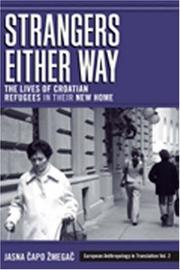| Listing 1 - 7 of 7 |
Sort by
|
Book
ISBN: 9780857453181 0857453181 0857451499 Year: 2007 Publisher: New York Oxford
Abstract | Keywords | Export | Availability | Bookmark
 Loading...
Loading...Choose an application
- Reference Manager
- EndNote
- RefWorks (Direct export to RefWorks)
Croatia gained the world's attention during the break-up of Yugoslavia in the early 1990s. In this context its image has been overshadowed by visions of ethnic conflict and cleansing, war crimes, virulent nationalism, and occasionally even emergent regionalism. Instead of the norm, this book offers a diverse insight into Croatia in the 1990s by dealing with one of the consequences of the war: the more or less forcible migration of Croats from Serbia and their settlement in Croatia, their ""ethnic homeland."" This important study shows that at a time in which Croatia was perceived as a homog
Book
ISBN: 8690296158 9788690296156 Year: 2007 Publisher: Beograd : Vukova Zadužbina,
Abstract | Keywords | Export | Availability | Bookmark
 Loading...
Loading...Choose an application
- Reference Manager
- EndNote
- RefWorks (Direct export to RefWorks)
Monasteries --- Monasteries --- History --- History --- Srem (Serbia and Croatia) --- Fruška Mountains (Serbia) --- Srem (Serbia and Croatia) --- Fruška Mountains (Serbia) --- History --- History --- Civilization --- Church history

ISBN: 9781845453176 Year: 2007 Publisher: New York (N.Y.) : Berghahn books,
Abstract | Keywords | Export | Availability | Bookmark
 Loading...
Loading...Choose an application
- Reference Manager
- EndNote
- RefWorks (Direct export to RefWorks)
Yugoslav War, 1991-1995 --- Croats --- Croats --- Refugees --- History --- Migrations --- History --- Srem (Serbia and Croatia) --- Srem (Serbia and Croatia) --- History --- Ethnic relations.
Map
Year: 1745 Publisher: [Nuremberg]: In lucem edita ab Homannianis Heredibus,
Abstract | Keywords | Export | Availability | Bookmark
 Loading...
Loading...Choose an application
- Reference Manager
- EndNote
- RefWorks (Direct export to RefWorks)
Slavonia (Croatia) --- Srem (Serbia and Croatia) --- Baranya Region (Hungary) --- Serbia --- Bosnia and Herzegovina
Book
Year: 1971 Volume: 29 Publisher: Beograd : [Archaeological Institute],
Abstract | Keywords | Export | Availability | Bookmark
 Loading...
Loading...Choose an application
- Reference Manager
- EndNote
- RefWorks (Direct export to RefWorks)
Romans --- Excavations (Archaeology) --- Srem (Serbia and Croatia) --- Yugoslavia --- Yougoslavie --- Antiquities, Roman. --- Antiquities, Roman --- Antiquités romaines
Periodical
ISSN: 18489109 Year: 2001 Publisher: Slavonski Brod : Podružnica za povijest Slavonije, Srijema i Baranje Hrvatskog instituta za povijest,
Abstract | Keywords | Export | Availability | Bookmark
 Loading...
Loading...Choose an application
- Reference Manager
- EndNote
- RefWorks (Direct export to RefWorks)
Slavonia (Croatia) --- Srem (Serbia and Croatia) --- Baranja (Croatia) --- Croatia --- Croatia. --- Europe --- History --- History, Local --- Slavonie (Croatie) --- Srem (Serbie et Croatie) --- Baranja (Croatie) --- Histoire
Book
ISBN: 9782503595504 2503595502 9782503595511 Year: 2022 Publisher: Turnhout Brepols
Abstract | Keywords | Export | Availability | Bookmark
 Loading...
Loading...Choose an application
- Reference Manager
- EndNote
- RefWorks (Direct export to RefWorks)
Les fouilles franco-yougoslaves dirigées conjointement par Noël Duval (1929-2018) et Vadislav Popovic (1930-1999), d’abord à Sirmium de 1973 à 1978, puis à Caričin Grad de 1978 à 1991, demeurent encore aujourd’hui un modèle de collaboration archéologique internationale. Du fait de leur impressionnant bilan, les deux missions participèrent pleinement à la mise en valeur du patrimoine romain sur le territoire de l’actuelle Serbie, de même qu’à la démonstration de l’intérêt de la période que l’on qualifie aujourd’hui d’Antiquité tardive. Dédié à la mémoire des deux grandes figures susmentionnées, le présent ouvrage unit les découvertes restées inédites de l’exploration franco-yougoslave de la basilique Saint-Irénée de Sirmium, menée entre 1976 et 1977, avec celles faites plus récemment, soit en 2002 et en 2016, à l’occasion des travaux conduits sur le site de la nécropole environnante de cette église paléochrétienne, par l’équipe de l’Institut archéologique de Belgrade. Les résultats obtenus par de véritables « pères fondateurs » se retrouvent donc ici associés à ceux de générations qui ont été formées dans la suite directe des importantes avancées scientiques, non seulement en termes de données, mais aussi de méthodologie, dont ils furent à l’origine.
Excavations (Archaeology) --- Srem (Serbia and Croatia) --- Antiquities, Roman. --- Archaeological digs --- Archaeological excavations --- Digs (Archaeology) --- Excavation sites (Archaeology) --- Ruins --- Sites, Excavation (Archaeology) --- Archaeology --- Sirmio (Serbia and Croatia) --- Srem (Serbia) --- Srijem (Serbia and Croatia) --- Syrmia (Serbia and Croatia) --- Syrmien (Serbia and Croatia) --- Szerém (Serbia and Croatia) --- 949.5.01 --- 902 <495 BYZANTIUM> --- 902 <495 BYZANTIUM> Archeologie--Griekenland--BYZANTIUM --- Archeologie--Griekenland--BYZANTIUM --- 949.5.01 Geschiedenis van Byzantium: Constantinus tot Theodosius III--(323-716) --- Geschiedenis van Byzantium: Constantinus tot Theodosius III--(323-716) --- Antiquities, Roman --- Architecture, Early Christian --- Tombs --- Inscriptions, Latin --- Human remains (Archaeology)
| Listing 1 - 7 of 7 |
Sort by
|

 Search
Search Feedback
Feedback About UniCat
About UniCat  Help
Help News
News